 W
WBingqian, or Bingxingqian, is a term, which translates into English as "biscuit coins", "pie coins", or "cake coins", used by Chinese and Taiwanese coin collectors to refer to cash coins with an extremely broad rim as, these cash coins can also be very thick. While the earliest versions of the Bingqian did not extraordinarily broad rims.
 W
WThe Chinese Gold Panda is a series of gold bullion coins issued by the People's Republic of China. The Official Mint of the People's Republic of China introduced the panda gold bullion coins in 1982. The panda design changes every year and the Gold Panda coins come in different sizes and denominations, ranging from 1⁄20 to 1 troy ounce.
 W
WThe Chinese Silver Panda is a series of silver bullion coins issued by the People's Republic of China. The design of the panda is changed every year and minted in different sizes and denominations, ranging from 0.5 troy oz. to 1 kilogram. Starting in 2016, Pandas switched to metric sizes. The 1 troy ounce coin was reduced to 30 grams, while the 5 troy ounce coin was reduced to 150 grams. There is also a Gold Panda series issued featuring the same designs as the Silver Panda coins.
 W
WChop marks on coins are Chinese characters stamped or embossed onto coins by merchants in order to validate the weight, authenticity and silver content of the coin. Depending on particular technique coins said to have been "chopmarked", "countermarked" and "counterstamped".
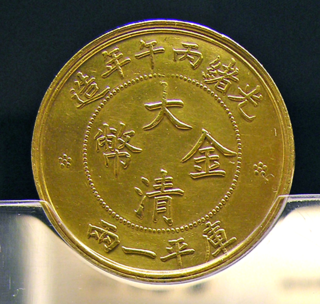 W
WThe Da-Qing Jinbi was the name of a unissued series of gold coins produced under the reign of the Guangxu Emperor. These coins were produced in the scenario that the government of the Manchu Qing dynasty would adopt the gold standard, as was common in most of the world at the time.
 W
WThe Da-Qing Tongbi, or the Tai-Ching-Ti-Kuo copper coin, refers to a series of copper machine-struck coins from the Qing dynasty produced from 1906 until the fall of the Qing dynasty in 1911. These coins were intended to replace the earlier cast cash coins and provincial coinages, but were welcomed to mixed receptions.
 W
WDaqian are large-denomination cash coins produced in the Qing dynasty starting from 1853 until 1890. Large denomination cash coins were previously used in earlier Chinese dynasties and had faced similar issues as 19th-century Daqian. The term referred to cash coins with a denomination of 4 wén or higher.
 W
WThe list of coin hoards in China lists significant archaeological hoards of coins, other types of coinages or objects related to coins discovered in China. The history of Chinese currency dates back as early as the Spring and Autumn period, and the earliest coinages took the form of imitations of the cowrie shells that were used in ceremonial exchanges. During the Warring States period new forms of currency such as the spade money, knife money, and round copper-alloy coins were introduced. After unification of China under the Qin dynasty in 221 BC the Ban Liang (半兩) cash coin became the standard coinage, under the Han dynasty the Wu Zhu (五銖) cash coins became the main currency of China until they were replaced with the Kaiyuan Tongbao (開元通寳) during the Tang dynasty, after which a large number of inscriptions were used on Chinese coinages. During the late nineteenth century China started producing its own machine-struck coinages.
 W
W"Red cash coins" are the cash coins produced in Xinjiang under Qing rule following the conquest of the Dzungar Khanate by the Qing dynasty in 1757. While in Northern Xinjiang the monetary system of China proper, with standard cash coins, was adopted in Southern Xinjiang where the pūl (ﭘول) coins of Dzungaria circulated earlier the pūl-system was continued but some of the old Dzungar pūl coins were melted down to make Qianlong Tongbao (乾隆通寶) cash coins, as pūl coins were usually around 98% copper they tended to be very red in colour which gave the cash coins based on the pūl coins the nickname "red cash coins".
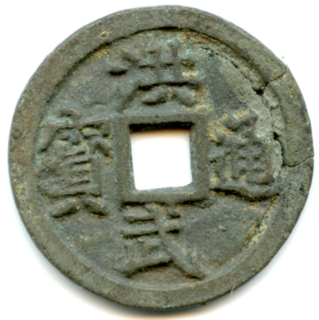 W
WThe Hongwu Tongbao was the first cash coin to bear the reign name of a reigning Ming dynasty Emperor bearing the reign title of the Hongwu Emperor. Hongwu Tongbao cash coins officially replaced the earlier Dazhong Tongbao coins, however the production of the latter did not cease after the Hongwu Tongbao was introduced. The government of the Ming dynasty placed a greater reliance on copper cash coins than the Yuan dynasty ever did, but despite this reliance a nationwide copper shortage caused the production of Hongwu Tongbao cash coins to cease several times eventually leading to their discontinuation in 1393 when they were completely phased out in favour of paper money. In the year 1393 there were a total of 325 furnaces in operation in all provincial mints of China which had an annual output of 189,000 strings of cash coins which was merely 3% of the average annual production during the Northern Song dynasty.
 W
WThe Jin dynasty was a Jurchen-led dynasty of China that ruled over northern China and Manchuria from 1115 until 1234. After the Jurchens defeated the Liao dynasty and the Northern Song dynasty, they would continue to use their coins for day to day usage in the conquered territories. In 1234, they were conquered by the Mongol Empire.
 W
WThe Kaiyuan Tongbao, sometimes romanised as Kai Yuan Tong Bao or using the archaic Wade-Giles spelling K'ai Yuan T'ung Pao, was a Tang dynasty cash coin that was produced from 621 under the reign of Emperor Gaozu and remained in production for most of the Tang dynasty until 907. The Kaiyuan Tongbao was notably the first cash coin to use the inscription tōng bǎo (通寶) and an era title as opposed to have an inscription based on the weight of the coin as was the case with Ban Liang, Wu Zhu and many other earlier types of Chinese cash coins. The Kaiyuan Tongbao's calligraphy and inscription inspired subsequent Central Asian, Japanese, Korean, Ryūkyūan, and Vietnamese cash coins and became the standard until the last cash coin to use the inscription "通寶" was cast until the early 1940s in French Indochina.
 W
WThe Liao dynasty was a Khitan-led dynasty of China that ruled over parts of Northern China, Manchuria, the Mongolian Plateau, northern Korean Peninsula, and what is modern-day Russian Far East from 916 until 1125 when it was conquered by the Jin dynasty. Remnants of the Liao court fled westward and created the Western Liao dynasty which in turn was annexed by the Mongol Empire in 1218.
 W
WChinese cash coins were first produced during the Warring States period, and they became standardised as the Ban Liang (半兩) coinage during the Qin dynasty which followed. Over the years, cash coins have had many different inscriptions, and the Wu Zhu (五銖) inscription, which first appeared under the Han dynasty, became the most commonly used inscription and was often used by succeeding dynasties for 700 years until the introduction of the Kaiyuan Tongbao (開元通寳) during the Tang dynasty. This was also the first time regular script was used as all earlier cash coins exclusively used seal script. During the Song dynasty a large number of different inscriptions was used, and several different styles of Chinese calligraphy were used, even on coins with the same inscriptions produced during the same period. These cash coins are known as matched coins (對錢). This was originally pioneered by the Southern Tang.
 W
WChinese coinage in the Ming dynasty saw the production of many types of coins. During the Ming dynasty of China, the national economy was developed and its techniques of producing coinage were advanced. One early period example is the Bronze 1 cash. Obverse: "Hongwu Tongbao" (洪武通寶). Reverse: blank. Average 23.8 mm, 3.50 grams.
 W
WQianlong Tongbao is an inscription used on cash coins produced under the reign of the Qianlong Emperor of the Qing dynasty. Initially the Qianlong Tongbao cash coins were equal to its predecessors in their weight and quality but as expensive military expenditures such as the Ten Great Campaigns began to take their financial toll on the government of the Qing dynasty the quality of these cash coins started to steadily decrease. The weight of the Qianlong Tongbao was changed several times and tin was added to their alloy to both reduce costs and to prevent people from melting down the coins to make utensils. As the intrinsic value of these coins was higher than their nominal value many provincial mints started reporting annual losses and were forced to close down, meanwhile the copper content of the coinage continued to be lowered while the copper mines of China were depleting. The Qianlong era also saw the conquest of Xinjiang and the introduction of cash coins to this new region of the Qing Empire.
 W
WQing dynasty coinage was based on a bimetallic standard of copper and silver coinage. The Manchu-led Qing dynasty was established in 1636 and ruled over China proper from 1644 until it was overthrown by the Xinhai Revolution in 1912. The Qing dynasty saw the transformation of a traditional cash coin based cast coinage monetary system into a modern currency system with machine-struck coins, while the old traditional silver ingots would slowly be replaced by silver coins based on those of the Mexican peso. After the Qing dynasty was abolished its currency was replaced by the Chinese yuan of the Republic of China.
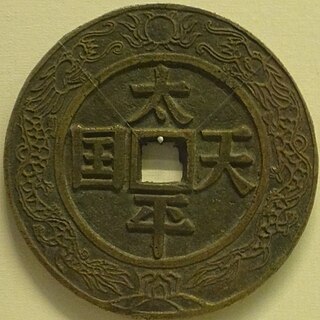 W
WThe currency of the Taiping Heavenly Kingdom consisted of Chinese cash coins and paper money, although the rarity of surviving Taiping paper money suggests that not much was produced. The first cash coins of the Taiping Heavenly Kingdom were issued in the year 1853 in the capital of Tianjing. The cash coins of the Taiping Heavenly Kingdom should not be confused with the Taiping Tongbao (太平通寳) which was issued during the Northern Song dynasty between the years 976 and 997, or with any other contemporary rebel coinage that also bear this inscription.
 W
WSilver Dragon coins, also sometimes known as Dragon dollars, are silver coins issued by China, Japan and later Korea for general circulation in their own countries. Featuring a dragon on the obverse of Japanese and Korean issues and on the reverse of Chinese issues, all were inspired by the silver Spanish dollar which following its introduction into the region in the 16th Century had set the standard for a de facto common currency for trade in the Far East, this specification being a weight of 27.22 grams and a fineness of .900; the coin thus contained 24.5 g of silver.
 W
WThe Southern Song dynasty refers to an era of the Song dynasty after Kaifeng was captured by the Jurchen Jin dynasty in 1127. The government of the Song was forced to establish a new capital city at Lin'an which wasn't near any sources of copper so the quality of the cash coins produced under the Southern Song significantly deteriorated compared to the cast copper-alloy cash coins of the Northern Song dynasty. The Southern Song government preferred to invest in their defenses while trying to remain passive towards the Jin dynasty establishing a long peace until the Mongols eventually annexed the Jin before marching down to the Song establishing the Yuan dynasty.
 W
WThe coinage of the Southern Tang kingdom consisted mostly of bronze cash coins while the coinages of previous dynasties still circulated in the Southern Tang kingdom most of the cash coins issued during this period were cast in relation to these being valued as a multiple of them.
 W
WA sycee or yuanbao (Chinese: t 元寶, s 元宝, p yuánbǎo, lit. 'valuable treasure') was a type of gold and silver ingot currency used in imperial China from its founding under the Qin dynasty until the fall of the Qing in the 20th century. Sycee were not made by a central bank or mint but by individual goldsmiths or silversmiths for local exchange; consequently, the shape and amount of extra detail on each ingot were highly variable. Square and oval shapes were common, but boat, flower, tortoise and others are known. Their value—like the value of the various silver coins and little pieces of silver in circulation at the end of the Qing dynasty—was determined by experienced moneyhandlers (shroffs), who estimated the appropriate discount based on the purity of the silver and evaluated the weight in taels and the progressive decimal subdivisions of the tael.
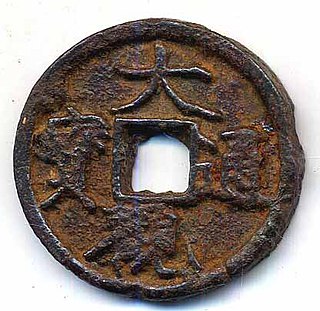 W
WIron cash coins are a type of Chinese cash coin that were produced at various times during the monetary history of imperial China as well as in Japan and Vietnam. Iron cash coins were often produced in regions where the supply of copper was insufficient, or as a method of paying for high military expenditures at times of war, as well as for exports at times of trade deficits.
 W
WTong Bei literally translated as "Bronze Cowry" or "Bronze Shell", is an ancient coin found in China.
 W
WThe Western Xia was a Tangut-led Chinese dynasty which ruled over what are now the northwestern Chinese provinces of Ningxia, Gansu, eastern Qinghai, northern Shaanxi, northeastern Xinjiang, southwest Inner Mongolia, and southernmost Outer Mongolia from 1032 until 1227 when they were destroyed by the Mongols. The country was established by the Tangut people; likewise its earliest coins were escribed with Tangut characters, while later they would be written in Chinese. Opposed to Song dynasty coins that often read top-bottom-right-left, Western Xia coins exclusively read clockwise. Despite the fact that coins had been cast for over a century and a half, very little were actually produced and coins from Western Xia are a rarity today. Although the Western Xia cast their own coins barter remained widely used.
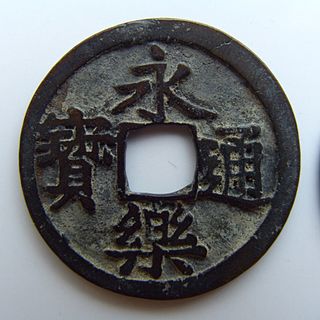 W
WThe Yongle Tongbao was a Ming dynasty era Chinese cash coin produced under the reign of the Yongle Emperor. As the Ming dynasty didn't produce copper coinage at the time since it predominantly used silver coins and paper money as the main currency, the records vary on when the Yongle Emperor ordered its creation between 1408 and 1410, this was done as the production of traditional cash-style coinage had earlier ceased in 1393. The Yongle Tongbao cash coins were notably not manufactured for the internal Chinese market where silver coinage and paper money would continue to dominate, but were in fact produced to help stimulate international trade as Chinese cash coins were used as a common form of currency throughout South, Southeast, and East Asia.
 W
WThe Yuan dynasty was a Mongol-ruled Chinese dynasty which existed from 1271 to 1368. After the conquest of the Western Xia, Western Liao, and Jin dynasties they allowed for the continuation of locally minted copper currency, as well as allowing for the continued use of previously created and older forms of currency, while they immediately abolished the Jin dynasty's paper money as it suffered heavily from inflation due to the wars with the Mongols. After the conquest of the Song dynasty was completed, the Yuan dynasty started issuing their own copper coins largely based on older Jin dynasty models, though eventually the preferred Yuan currency became the Jiaochao and silver sycees, as coins would eventually fall largely into disuse. Although the Mongols at first preferred to have every banknote backed up by gold and silver, high government expenditures forced the Yuan to create fiat money in order to sustain government spending.
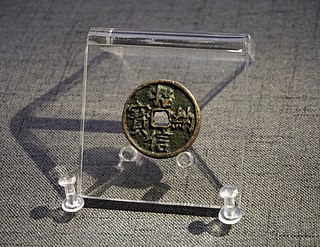 W
WThe Zhaona Xinbao is a special type of Southern Song dynasty cash coin developed as a propaganda and psychological warfare tool for recruiting defectors from the army of the Jurchen Jin dynasty around the year Shaoxing 1 under the reign of Emperor Gaozong. These special coins superficially resemble traditional Chinese cash coins but contain an inscription alluding to their intent, generally these Zhaona Xinbao tokens were made from bronze but in very rare cases they were also made from silver or gold.
 W
WStandard cash, or regulation cash coins, is a term used during the Ming and Qing dynasties of China to refer to standard issue copper-alloy cash coins produced in imperial Chinese mints according to weight and composition standards that were fixed by the imperial government. The term was first used for Hongwu Tongbao cash coins following the abolition of large denomination versions of this cash coin series.
 W
W W
W W
W